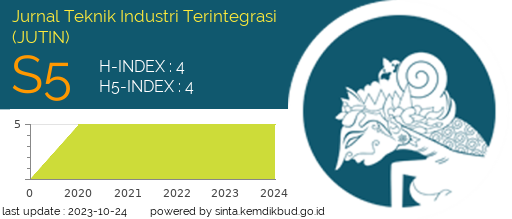Pembuatan Carboxymethyl Cellulose (CMC) Dari Batang Kelapa Sawit
DOI:
https://doi.org/10.31004/jutin.v7i1.25815Keywords:
Alkalyzation, Carboxymethylation, CMC, Stem, Palm OilAbstract
81.5 million m3 of palm oil stem is produced every year. Stem fiber can be used as source of cellulose for the making of carboxymethyl cellulose(CMC). CMC is widely used in the pharmaceutical, food, textile and cosmetic industries. The aim of this research is to determine the best reaction time. The procedure consists of 3 initial stages and 2 core stages, namely, sample preparation, reducing the size to 50 mesh, delignification using a 15% NaOH solution for 3 hours, bleaching using a 6% NaOCl solution for 3 hours, alkalization using isopropanol and alkalized with 15% NaOH for 1 hour, in the carboxymethylation stage, sodium monochloroacetate (NaMCA) was added with time variations of 2, 3, 4, 5 and 6 hours. The results showed that 5 hours reaction times produces CMC with degree of substitution of 1.64, a viscosity of 123.5 cP, a pH of 6.1 and a water content of 1.2%.References
Abe H, Murata Y, Watanabe K. 2013. Estimation of The Ratio of Vascular Bundels to Parenchyma Tissue in Oil Palm Trunks Using NIR Spectroscopy. Bioresource. 8 (2): 1573-1581
Adden, A. 2009. Substitution Pattern In and Over Polymer Chains – New Approaches for Carboxymethyl Cellulose. Dissertation of Engineering Faculty Carolo- Wilhelmina University, Hannover.
Agustriono, Rahayu F, Hasanah N.2013. Pemanfaatan Limbah sebagai Bahan Baku Sintesis Karboksimetil Selulosa. Farmaka 4, No. 3 Hal. 1- 11.
Almlof, H. 2010. Extended Mercerization Prior to Carboxymethyl Cellulose Preparation. Department of Chemical Engineering, Faculty of Technology and Science, Karistads University. Sweden.
Fauzi, Y., Widyastuti, Satyawibowo, Hartono.2007. Kelapa Sawit. Penebar Swadaya. Jakarta
Ferdiansyah. 2016. Kajian Karakteristik Karboksimetil Selulosa (CMC) dari Pelepah Kelapa Sawit sebagai Upaya Diversifikasi Bahan Tambahan Pangan yang Halal. Jurnal Aplikasi Teknologi Pangan 5 (4).
Hercules. 1999. Aqualon Sodium Carboxymethyl Cellulose. North Market Street.
Wilmington.
Hong. 2013. Preparation and Characterization of Carboxymethyl Cellulose from Sugarcane Bagasse. Department of Chemical Science Faculty of Science Universiti Tunku Abdul Rahman
Kontturi, E. 2015. Cellulose : Chemical Modification. Aalto University School of Chemical Technology.
Lai, Wong, Idris. 2013 Disruption of Oil Palm Trunks and Fronds by Microwave-Alkaline Pretreatment. Bioresource. 8(2): 2792-2804
Latif. 2007. Two Step Synthesis and Characterization of CMC from Rayon Grade Wood Pulp and Cotton Linter. Journal Chem.Soc.Pak.Vol 29 No 2, 2007.
Melda P. (2018). “Sintesis dan Karakterisasi CMC (Carboxymethil Cellulose) dari Selulosa Batang Pisang Raja (Musa Paradisiaca) dengan
Melisa. 2014. Optimasi Sintesis Karboksimetil Selulosa dari Tongkol Jagung Manis (Zea Mays L Saccharata). Online Jurnal of Natural Science, Vol.3 (2): 70-78 Agustus 2014.
Nisa, Dianrifiya, Putri R. (2014). “Pemanfaatan Selulosa dari Kulit Buah Kakao (Teobroma Cacao L.) Sebagai Bahan Baku Pembuatan CMC (Carboxymethil Cellulosa)”. Pangan dan Agroindustri 2, no. 3 h. 3442.
Nisa, Dianrifya. 2014. Pemanfaatan Selulosa dari Kulit Buah Kakao (Teobroma cacao L.) Sebagai Bahan Baku Pembuatan CMC (Carboxymethyl Cellulose). Jurnal Pangan dan Agroindustri Vol.2 No.3 p.34-42, Juli 2014. Jurusan Teknologi Hasil Pertanian, FTP Universitas Brawijaya Malang.
Nur, R. 2016. “Sintesis dan Karakterisasi CMC (Carboxymethyl Cellulosa) yang Dihasilkan dari Selulosa Jerami Padi”. Sains dan Teknologi Pangan 1, no. 2 h. 222-231.
Nur’ain. 2017. “Optimasi Kondisi Reaksi untuk Sintesis Karboksimetil Selulosa (CMC) dari Batang Jagung (Zea Mays L.)”. Riset Kimia 3, no. 2 h. 112-121.
Pushpamalar, V. S.J. Langford, M. Ahmad, Y.Y, Lim, 2006. Optimization of Reactions Conditions for Preparing Carboxymethyl Cellulose from Sago Waste. Carbohydr. Polym, 64: 312-318.
Pustekolah. 2013. Kayu Sawit: Mengubah Sampah Menjadi Rupiah [Online],
http://www.pustekolah.org/index.php/detail/321/SIARAN-PERSKayu-Sawit-Mengubah-SampahMenjadiRupiah
September 2023].
Santoso. 2012. Pemanfaatan Kulit Singkong sebagai Bahan Baku Pembuatan Natrium Karboksimetil Selulosa. Jurnal Teknik Kimia Indonesia Vol. 11, No. 3, 2012, 124-131.
SNI, Standar Nasional Indonesia. 1969. SNI 03-1969: Cara Uji Kadar Air: Badan Standardisasi Nasional.
SNI, Standar Nasional Indonesia. 1995. SNI 06-3736-1995: Natrium Karboksimetil Selulosa Teknis. Jakarta: Badan Standardisasi Nasional.
SNI, Standar Nasional Indonesia. 1998. SNI 06 4558-1998: Cara Uji Viskositas Natrium Karboksimetil Selulosa. Jakarta: Badan Standardisasi Nasional.
SNI, Standar Nasional Indonesia. 2008. SNI 0492-2008: Pulp dan kayu- Cara uji kadar lignin-metode klason: Badan Standardisasi Nasional.
Wijayani. 2005. Karakterisasi Karboksimetil Selulosa (CMC) dari Enceng Gondok (Eichorniacrassipes (Mart) Solm), A Review: Indo. J. Chem., 2005, 5(3), 228-231).
Yuanisa, A. 2015. Pretreatment Lignoselulosa Batang Kelapa Sawit Dengan Metode Microwave Sebagai Upaya Pembuatan Bioetanol Generasi Kedua. Skripsi. Jurusan Teknologi Hasil Pertanian. FTP UB. Malang
Downloads
Published
How to Cite
Issue
Section
License
Copyright (c) 2024 Razita Hariani, Fatmayati Fatmayati

This work is licensed under a Creative Commons Attribution-ShareAlike 4.0 International License.





